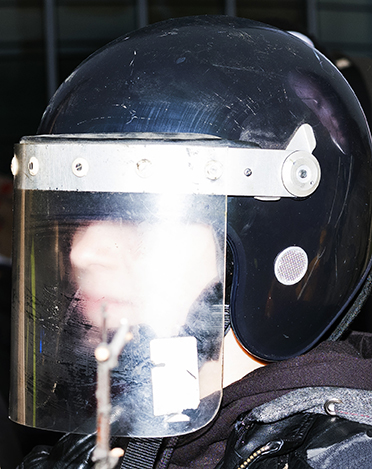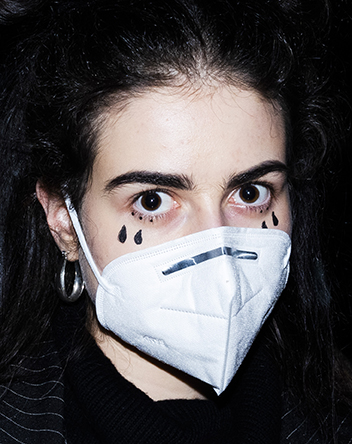Eva-Luna Tholance
Eva-Luna Tholance
ON TEARGAS, MISCARRIAGE, AND BUILDING FEMINIST KNOWLEDGE
Edited by Caline Nasrallah
Translated from English by Raja Salim
Photography by Rafal Milach

“I was so close to the police officer at the protest that when he sprayed tear gas on us, I felt it was still liquid under my lids. Two days after that, my period came way too early, with cramps stronger than my endometriosis usually causes. It felt like the gas had ripped my period from my body.”
These are the terrifying words of Julie, one of the first people who testified to me about the effects that being exposed to tear gas (or CS gas) has had on her reproductive health. When she told me her story, I had just started investigating this subject. I had seen Instagram posts warning Black Lives Matter protesters that tear gas exposure could cause miscarriages, and this set me on a path I just couldn’t ignore. There were two main points that struck me. First, I found alarming that the correlation between an increasing number of miscarriages and massive tear gas use has actually been lightly circulated for at least three decades. This is not brand new information, and yet – and this is the second point I want to emphasize – almost no one, throughout these three decades, has deemed that this issue warrants any further research.
A Washington Post article[1] from as far back as 1988 mentions, “Palestinian doctors and officials working for the U.N. Relief and Works Agency (UNRWA) that operates the refugee camps contend there have been more than 1,200 injuries, dozens of miscarriages and at least 11 deaths from tear gas” in December of that year. That same year, during the June Democratic Struggle, similar stories emerged from South Korea. Fast-forward to 2011, Chile made the use of tear gas illegal for a week, after toxicologist Andrei Tchernitchin from the University of Chile warned the population about the risk of miscarriages after exposure. But this was quickly brushed under the rug, as Tchernitchin did not have enough conclusive data to confirm his hypothesis.
Physicians for Human Rights (PHR) published what is shockingly one of the most extensive reports about this issue in their investigation on the government of Bahrain’s use of tear gas in 2012 [2]: a mere three paragraphs in a 60-page document. They include the worried words of a nurse working in an area frequently exposed to tear gas, which was being used to repress civilians protesting against their oppressive government:
“There are many, many miscarriages. We believe the miscarriage rate has increased, although there is no quantitative evidence. What I want to know is: What is this gas… and what will future complications be?”


When asked about this concise yet alarming report, Rohini Haar from PHR explained that the organization “wanted to give some credit to these women’s experiences,” but that the gathered testimonies didn’t count as evidence, and that it wouldn’t be possible to conduct more studies on this issue, “as you can’t ethically put a bunch of pregnant people together and expose them to tear gas.”
Ms Haar added that she didn’t think “it was worth mentioning, because tear gas was known to impact all different body parts.” But knowing this, and knowing how frequently governments use tear gas to control crowds and suppress protests, I became more and more worried about the disquieting correlation and thought it necessary that the correlation be used to pressure governments to stop using tear gas. When this has been happening for years, though –and more importantly, when this has been dismissed for years–what could possibly constitute good enough evidence for an issue that scientists and lawmakers routinely brush aside?
These questions led me to Gina Martinez from the Colorado Doula Project, an organization that was posting warnings for pregnant people protesting in the US. “We have more than thirty years of reports from humanitarians, activists, and people who have been exposed themselves and experienced unexpected bleedings or miscarriages. Even if there is no way to find clinical data, the information that we have is still data,” she says. Consistent patterns emerging from a specific context, at a specific place and time, surely constitute proof that, if not incontrovertible, at the very least should not be ignored. So, as it appeared that those reports were the only way to attract attention on this subject, I decided to gather as many of them as I could.
What tear gas does to our bodies
I have to this day gathered 140 testimonies of reproductive health disruptions due to tear gas exposure. These reports have come from women, trans men, and non-binary people in France, where I live, and most of them are from protests that happened in 2020. Out of these 140 people, four experienced miscarriages after protests that were heavily repressed. Eva, who is 26, explains that she was exposed to tear gas for an hour straight, most of which she spent confined in a shop to avoid police violence.
“I became pregnant despite a hormonal IUD,” she explains, “and when I came home from the protest, after not having had my period for two and a half years, I miscarried. I didn’t know I was pregnant, but I knew what a miscarriage felt like because I had miscarried twice before. For a month and a half after that, I experienced heavy cramps and bleeding.”
The other testimonies reveal a diverse range of symptoms, the most common being painful cramps (62% of the reports), an early period with heavy bleeding (43%), and ovarian cramps (35%). On the other hand, a small portion of the respondents reported getting a delayed period (20.5%) and experienced spotting or lighter bleeding than normal (7%). Nineteen people had their period come back despite the fact that they were post-menopausal, using hormonal contraceptives, or taking testosterone. Almost half of the respondents experienced these symptoms more than once.
Alexander Samuel, a French biologist who worked on the effects of tear gas (and the cyanide it contains) on the human body during the Yellow Vests movement, reached a hypothesis as to why these symptoms occur: cyanide cuts off the oxygen supply in our blood, which causes hypoxia in the uterus, a process that happens naturally during the menstrual cycle. It triggers the growth of the uterine lining and causes menstrual cramps. Because of the high cyanide content in tear gas, it seems logical that it would cause a miscarriage. However, this is still a hypothesis, and for the reasons mentioned above, it will probably remain as such for a while.
Asha Hassan, a Planned Parenthood employee and a doctoral student at the University of Minnesota School of Public Health, has also been researching this same topic. “When I started browsing the Internet for a medical reason for this and was coming out empty,” she explains in an interview for NowThis, “I felt it was my responsibility as a Planned Parenthood employee, as a researcher, as a Black scientist, to investigate this.” According to the study that she co-published in April this year[3], half of the menstruating people who participated reported having their menstrual cycle affected by tear gas exposure, which is consistent with the results that I have gathered.




The medical field where we don’t exist
It is no news that women, gender minorities, people of color, and people with disabilities have historically been excluded from performing science and medicine, especially gynecology. In Witches, Midwives, and Nurses: A History of Women Healers, Barbara Ehrenreich and Deirdre English explain that during the 18th and 19th centuries, rich white cis men actively took over the medical profession. “Our subjection is reinforced by our ignorance and we are made to stay that way. […] Science, as we have been taught, is out of our reach.” They carry on explaining that empirical women healers have been slowly discredited from performing medicine all the way through the lower classes, which made them secondary in obstetrics—a field that had always been reserved to them. “The repression of women healers is a political struggle because it echoes with the situation of women in history,” say Ehrenreich and English. Colonization has mirrored this, demonizing the traditional medicine of indigenous people and people of color.
The shortest glance at the history of obstetrics and gynecology is enough to show how riddled it is with sexist, ableist, and racist violence. What better example to use than that of James Marion Sims, the paradoxical “father of gynecology,” who invented the first version of the speculum while performing surgery on slave women without anesthetics, arguing that Black people could not feel pain anyway. Unsurprisingly, only the names of three of these Black women have survived through history: Lucy, Anarcha, and Betsey.
Another more recent example is that of Eva, who also happens to be a Black woman. She recounts this experience of consulting her gynecologist after miscarrying because of exposure to tear gas in 2020:
“Because I had an IUD and Crohn’s disease, the doctor refused to believe that I could be pregnant, and thus refused to treat me for it. I was alone and had to deal with pain and bleeding for a month afterwards.”
Unfortunately but unsurprisingly, this scenario is no exception to the rule: too often, doctors refuse to believe women–especially women of color–and people with disabilities when they express pain. This further excludes these already marginalized people from access to appropriate treatment and healthcare, and thus a better quality of life. Johanna Soraya, a French anti-racist, feminist, and anti-ableist activist explains that “even though pathologies such as endometriosis or polycystic ovarian syndrome impact all aspects of our lives and can be debilitating to some extent, we are never made a priority as a study subject.”
As feminists, gathering data and creating knowledge outside of the hegemonic medical system allows us to make enlightened choices for our health and our bodies.
Though operating outside the (not-so-invisible) hegemonic barriers may seem daunting, it is possible, and it is happening. The way people are coming together from all over the world to gather data proving the potential negative effects of tear gas on reproductive health is the best proof of grassroots movements’ effectiveness. “I do not tell pregnant people what to do,” explains Gina Martinez. “The responsibility is on our governments and on the police for using harmful chemicals. But I believe that pregnant people and people who could become pregnant should know that there can be side effects to protesting and make an enlightened decision.”
But even though knowledge is power and could therefore make space for the bodily autonomy of women, people of color, and people with disabilities, the true power still lies in the hands of governments that use these toxic gases against their populations.
Building on this, the change that we deserve must then be demanded from our governments. The fact is that tear gas endangers pregnant people and people who menstruate. Tear gas is a tool of police violence, which itself is a pillar of racist oppression. We have all the tools we need to ban the use of tear gas for crowd control. Spread the word, share the data, let it be clear that tear gas is more than a “less-than-lethal” weapon. It is an extremely toxic one. With networks of allies, we can sound the alarm and act on the ground during protests to warn people about the effects of being exposed to tear gas. The world must know that no one should be poisoned when using our human right to protest the systems that oppress us, and that gynecological and reproductive health are essential to the health of all people.
Bridging the gap between feminist theory and praxis, especially when it comes to healthcare, is a pressing need. It is not enough to invade institutions and occupy space with our non-compliant bodies, but we must create our own networks of healers who are women, people of color, queer, and disabled, as Johanna Soraya urges us to do, and we must go to medical appointments with friends and family to ensure adequate care. This would change our relationship to doctors and the medical field. But Soraya also imagines a society where we create our own relationship with our health and bodies, reclaiming what is ours. She suggests we learn self-help and share our experiences of self-diagnosis, as well as our symptoms, in our own spaces. She emphasizes the importance of making room and amplifying the voices of people of color who can’t speak of their health or even consider its value.
“By learning to care for our physical and metaphysical body and letting it rest, we create the possibility of healing for the ancestors who could not do so. This shows the next generations that care will make our communities stronger.”

